“…reliance on non-renewable natural resources (NNRs), which enabled us to do more things than we did before we began that reliance, has made us vulnerable. Such reliance is a commitment to impermanence.” (Catton)
The Paradox of Human Industrialism
For approximately three million years, our hunter-gatherer ancestors subsisted on renewable natural resources (RNRs) – water, soil, and naturally-occurring plants and animals; their hunter-gatherer way of life was sustainable.
During the next 12 thousand years, our agrarian ancestors added human-modified renewable Earth resources – domesticated and cultivated plants and animals – to the mix; their agrarian way of life was “quasi-sustainable”.
During the past 250 years, our industrial existence has been enabled by our ever-increasing utilization of finite and non-replenishing nonrenewable natural resources (NNRs) – fossil fuels, metals, and nonmetallic minerals. Our industrialized way of life is terminally unsustainable – it is irreversibly self-eradicating.
Paradoxically, then, because industrialism is enabled by finite and non-replenishing NNRs, we uniquely ingenious industrial Homo sapiens have been in the process of undermining our species’ existence for the past 250 years.
No other species on Earth, past or present, has managed to live beyond subsistence level, much less to achieve the extraordinary prosperity enjoyed by industrial humanity, because no other species has possessed the ingenuity required to exploit NNRs on an industrial scale.
The Demise of Human Industrialism
As one of the millions of species that inhabit planet Earth, Homo sapiens is subject to the same ecological laws of Nature that govern all other species. With respect to our industrial existence and to the Earth resource utilization behavior by which it is enabled, one natural law is paramount: “Net Depletion” of Earth Resource Reserves is Unsustainable.
That is, the rate at which an Earth resource reserve is depleted must not exceed the rate at which the reserve is replenished. Persistent “net depletion” will inevitably render the Earth resource reserve insufficient to support dependent species populations.
Given that all NNR depletion constitutes “net depletion”, persistent human NNR depletion – especially depletion on an industrial scale – will inevitably render Earth’s NNR reserves insufficient to support our NNR-dependent species. Unfortunately for humankind, “inevitably” is “now”.
Trend Reversals
During the mid-20th century, the fundamental trends that govern the evolution of our industrial era – relative global NNR scarcity and global human prosperity improvement – transitioned permanently from favorable to unfavorable.
Global NNR Scarcity. As illustrated by the Global NNR Scarcity Index – an indicator of aggregate relative global NNR scarcity between 1900 and 2019 – the secular (long term) global NNR scarcity trend transitioned permanently from “relative NNR abundance” to “increasing NNR scarcity” during the mid-20th century.
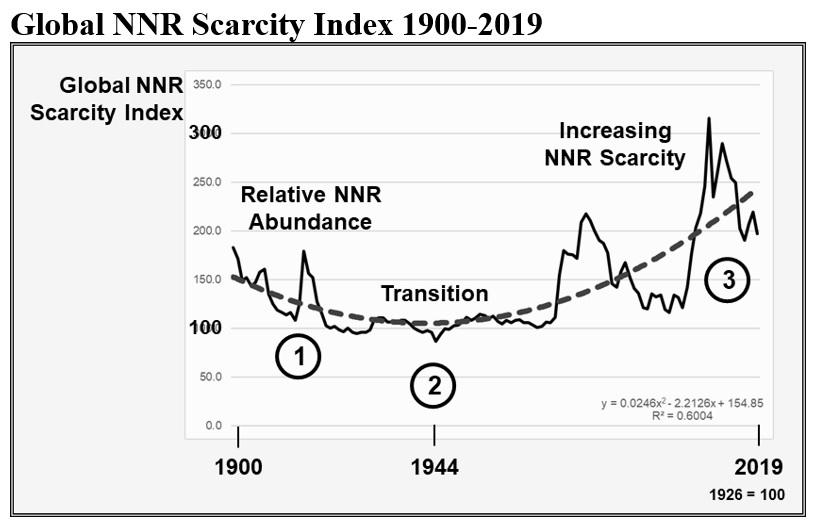
Global NNR Scarcity Index Trendline = Dashed Line.
Composite NNR Price Curve = Solid Line.
Sources: USGS, BP Statistical Review, US EIA, and others.
Click on the image to enlarge.
1. Between 1900 and 1944, the Global NNR Scarcity Index (dashed line) decreased by 33%, from 152 to 102, indicating relative global NNR abundance during the 44-year period.
2. In 1944, the Global NNR Scarcity Index reached its minimum of 102, indicating a permanent transition from relative global NNR abundance to increasing global NNR scarcity.
3.Between 1944 and 2019, the Global NNR Scarcity Index increased by an extraordinary 150%, from 102 to 248, indicating increasingly pervasive global NNR scarcity during the most recent 75-year period.
Global Human Prosperity. The mid-20th century transition from relative global NNR abundance to increasingly pervasive global NNR scarcity caused a nearly simultaneous, permanent transition from rapidly improving global human prosperity to faltering global human prosperity.
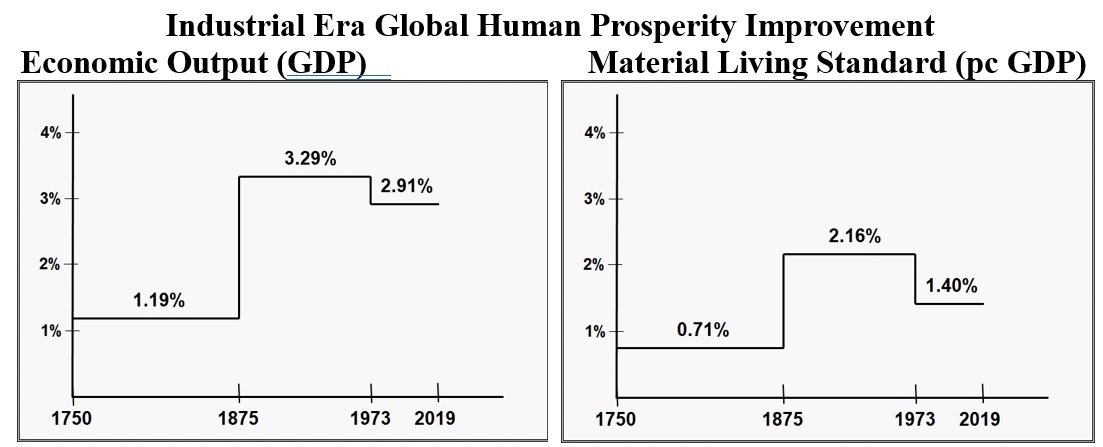
Sources: Delong, World Bank, and Macrotrends.
Click on the image to enlarge.
Between 1750 and 1875, global human prosperity improved rapidly by pre-industrial standards. Global GDP (economic output) increased by 1.19% compounded annually, while global pc GDP (the average material living standard) increased by 0.71% compounded annually.
Between 1875 and 1973, global human prosperity improved extraordinarily – despite WW1, the 1918-1919 global flu pandemic, the Great Depression, and WW2. Global GDP (economic output) increased by an unprecedented 3.29% compounded annually, while global pc GDP (the average material living standard) increased by an equally unprecedented 2.16% compounded annually.
Between 1973 and 2019, global human prosperity faltered – despite the remarkable industrialization initiatives launched by China and other Eastern nations. The increase in global GDP (economic output) diminished considerably to 2.91% compounded annually, while the increase in global pc GDP (the average material living standard) slowed to an anemic 1.40% compounded annually.
In the process of applying our unparalleled ingenuity toward achieving previously inconceivable prosperity, we extracted Earth’s high quality, low cost, and low priced NNRs. What remains are Earth’s low quality, high cost, and high priced NNRs – at a time when our ever-increasing NNR requirements are greater than ever!
Trend Acceleration
During the first two decades of the 21st century, the unfavorable trends that were established during the mid/late 20th century – increasingly pervasive global NNR scarcity and faltering global human prosperity – accelerated.
Accelerating Global NNR Scarcity. NNR prices increased to historically unprecedented levels during the first two decades of the new millennium, indicating accelerating global NNR scarcity during the period.
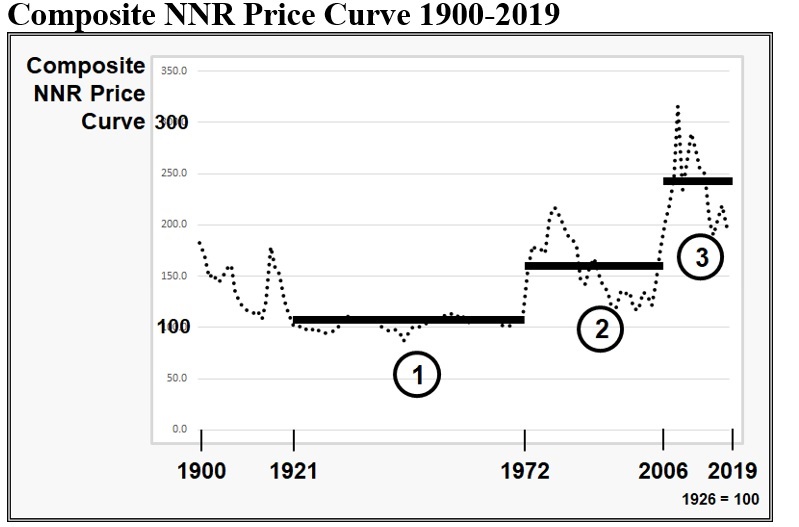
Sources: USGS, BP Statistical Review, US EIA, and others.
Click on the image to enlarge.
1. During the latter years of our Old Normal, between 1921 and 1972, which was characterized by relative global NNR abundance (Nature’s Stimulus), the Composite NNR Price Curve averaged a historically low 103.
2 .During the pre-Great Recession years of our New Normal, between 1973 and 2006, which was characterized by increasingly pervasive global NNR scarcity (Nature’s Squeeze), the Composite NNR Price Curve averaged 159, which was 54% greater than the historically low level of 103 that existed between 1921 and 1972.
3. From the Great Recession forward, between 2007 and 2019, which has been characterized by accelerating global NNR scarcity (Nature’s Squeeze tightens), the Composite NNR Price Curve has averaged 242, which is 52% greater than the 159 level that existed between 1973 and 2006 – and 135% greater than the historically low level of 103 that existed between 1921 and 1972.
By the dawn of the 21st century, most NNR deposits discovered since the inception of our industrial era had been extensively depleted, and significant new global NNR frontiers no longer existed. Accelerating global NNR scarcity – as indicated by inordinately high and rapidly increasing NNR price levels – was the inescapable consequence.
Rapidly Faltering Global Human Prosperity. Accelerating global NNR scarcity during the new millennium has constrained human prosperity improvement to rates that are substantially below those that existed prior to the Great Recession, and significantly below those that existed during the mid-20th century.
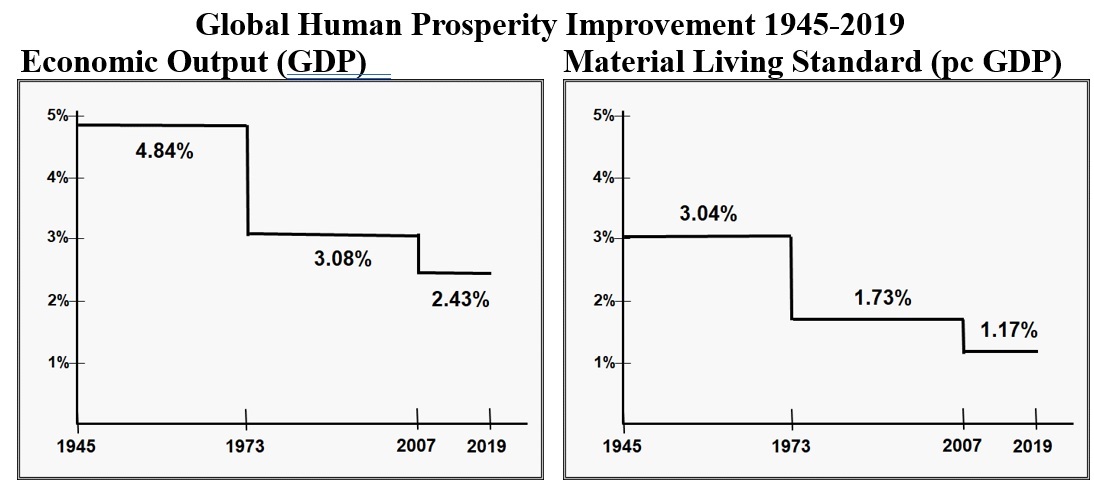
Sources: Delong, World Bank, and Macrotrends.
Click on the image to enlarge.
During the post-WW2 rebuilding period and the culmination of our Old Normal, between 1945 and 1973, global GDP (economic output) increased at an unprecedented 4.84% compounded annually, while the global pc GDP (the average material living standard) increased at an equally unprecedented 3.04% compounded annually.
During the pre-Great Recession years of our New Normal, between 1973 and 2007, the compound annual growth rate in global GDP (economic output) decreased substantially, from 4.84% to 3.08%, while the compound annual growth rate in pc GDP (the average material living standard) decreased substantially as well, from 3.04% to 1.73%.
During the Great Recession and post-recession “non-recovery”, between 2007 and 2019, the compound annual growth rate in global GDP (economic output) further decreased from 3.08% to a lackluster 2.43%, while the compound annual growth rate in global pc GDP (the average material living standard) further decreased from 1.73% to a meager 1.17% – despite historically unprecedented global fiscal and monetary “stimulus” employed during the period.
The notion that global human prosperity will ever again improve at rates that approach those that were achieved during the mid-20th century is geologically impossible. The high quality/low cost NNRs that enabled such prosperity improvement during industrialism’s “golden age” have long since been extracted.
It is unsurprising, therefore, that a post-GR “recovery” has failed to materialize. Rather, human industrialism is devolving toward collapse.
Devolution to Collapse
Going forward, as Nature’s Squeeze tightens relentlessly and remorselessly, and global human prosperity peaks and enters terminal decline, industrial humanity will crack, and human industrialism will collapse.
Nature’s Squeeze Will Tighten. In attempting to address our enormous and ever-increasing global NNR requirements, we will further deplete Earth’s already extensively depleted NNR reserves – which will further decrease NNR quality, which will further increase NNR exploitation costs, which will further increase NNR price trends – and further accelerate global NNR scarcity.
Nature’s Squeeze Will Tighten
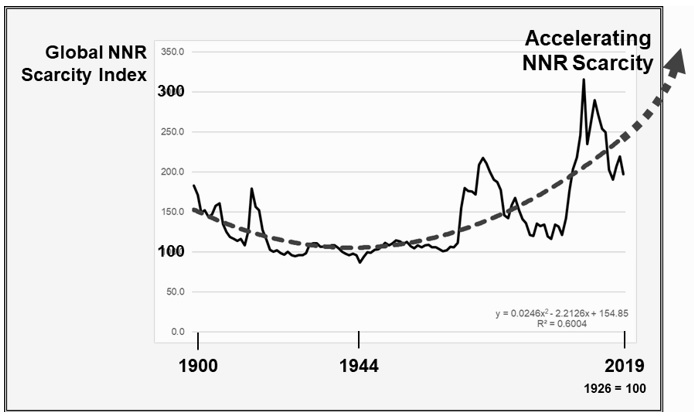
Click on the image to enlarge.
As billions of people seek to perpetuate their industrial existence, as billions more continue to industrialize, and as billions more attempt to industrialize, increasingly unfavorable global NNR demand/supply dynamics will engender increasingly severe and protracted resource wars. Extensively depleted global NNR reserves will become irreparably damaged – and will ultimately become permanently unproductive.
Industrial Humanity Will Crack. Continuously increasing NNR price trends caused by accelerating global NNR scarcity will further suppress global NNR demand and utilization, which will further diminish global human prosperity improvement.
Industrial Humanity Will Crack
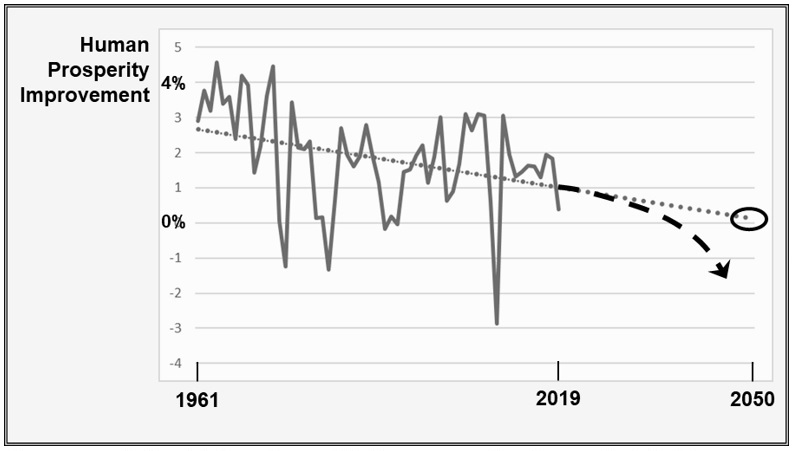
Sources: World Bank and Macrotrends through 2019.
Click on the image to enlarge.
Extrapolating the linear trendline (dotted line) derived from the 1961-2019 global pc GDP growth curve (solid line) indicates 0% global pc GDP growth – “peak human prosperity” – by the middle of the 21st century.
It is almost certain, however, that accelerating global NNR scarcity will cause faltering global human prosperity to accelerate as well, thereby “bending” the declining trajectory of the human prosperity improvement trendline from “downward linear” (dotted line) to “downward accelerating” (dashed line).
As global human prosperity plummets, social cohesion will be displaced by social entropy, and Earth’s human population will be ravaged by war, starvation, pestilence, and disease. Self-preservation will become the primary human objective, as the veneer of civilization completely disappears.
Human Industrialism Will Collapse. As extensively depleted and irreparably damaged Earth resource reserves become permanently unproductive, all industrialized nations – irrespective of their political ideologies, economic systems, and societal orientations – will collapse, completely and permanently, taking the aid-dependent, non-industrialized nations with them.
Human industrialism and industrial humanity will cease to exist – almost certainly by the year 2050.
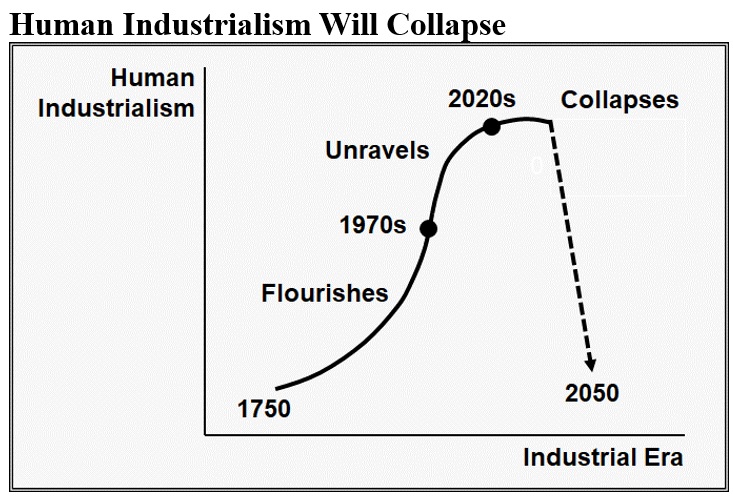
Click on the image to enlarge.
Under the best-case post-collapse scenario, a few million Homo sapiens will eke out a subsistence level existence by scavenging among the remnants of Earth’s once-abundant resources. Under the worst-case scenario, our species will go extinct.
We Are Exceptional… It is certainly not the case that our quest for universal prosperity through global industrialism – and the unsustainable Earth resource utilization behavior by which our quest is enabled – are inherently evil. We Homo sapiens have simply behaved like any species that is introduced into a habitat in which it can succeed. We succeeded – and thrived – because we could.
We employed our unparalleled ingenuity – our resourcefulness, technological innovations, efficiency improvements, and productivity enhancements – during the past three centuries to dramatically improve our prosperity, through our ever-increasing utilization of Earth’s finite and non-replenishing NNRs.
But NOT “Exemptional”… It is the case, however, that despite our possibly justifiable naïveté as we ascended to industrial exceptionalism, and despite the fact that our predicament is an unintended consequence of our understandable efforts to continuously improve our prosperity, neither our NNR utilization behavior nor our industrialized way of life is sustainable.
Humanity’s fate was sealed during the 18th century, at the inception of our industrial era. The NNR genie was released from the bottle and could not be put back. We remained ignorant of our inevitable fate during the 19th and 20th centuries, by misconstruing our windfall of temporary NNR abundance as permanent NNR sufficiency. We are now paying the price for our ignorance.
We will soon discover that while we industrial Homo sapiens are indeed exceptional, we are not “exemptional” – having somehow transcended the ecological laws of Nature that apply to all “lesser species”. Rather, we are the extraordinarily fortunate beneficiaries of a one-time, rapidly-depleting, natural legacy; and we are the unwitting and tragic victims of our own ingenuity.
NNR-enabled industrialism is humanity’s commitment to impermanence.
|
ABOUT THE AUTHOR
Since 2006, Chris Clugston has conducted extensive research into industrialism and its evolution, with a focus on NNRs (nonrenewable natural resources) – the fossil fuels, metals, and nonmetallic minerals that comprise the infrastructure, machines, products, and energy that perpetuate our industrial existence.
Clugston’s analyses consider how our industrial existence is enabled, why it is self-terminating, and why it is unraveling toward imminent collapse. His writings include three books pertaining to increasingly pervasive global NNR scarcity, and its implications for industrial humanity:
Clugston’s work experience includes forty years in the high technology electronics sector, primarily with telecommunications, data communications, and test & measurement companies. He held positions in marketing, sales, finance, and M&A, prior to becoming a corporate chief executive and later a management consultant.
Clugston received an AB/Political Science, Magna Cum Laude and Phi Beta Kappa, from Penn State University, and an MBA/Finance with High Distinction from Temple University in Philadelphia, PA.
|